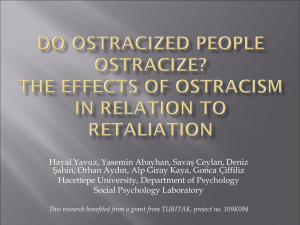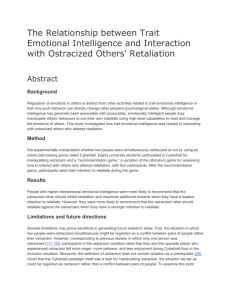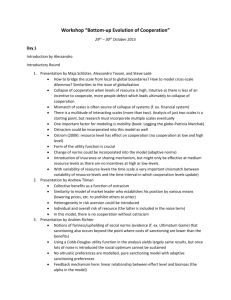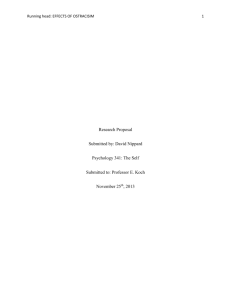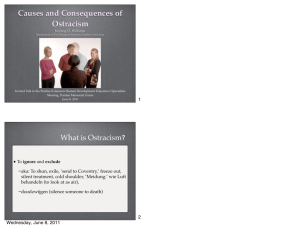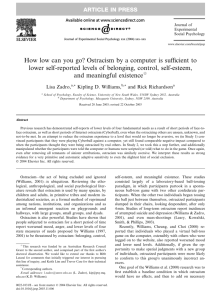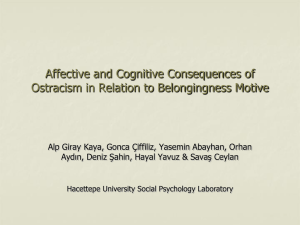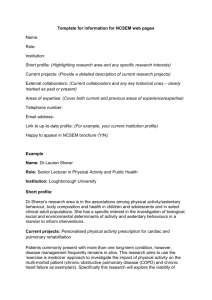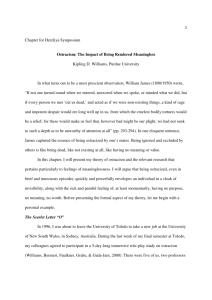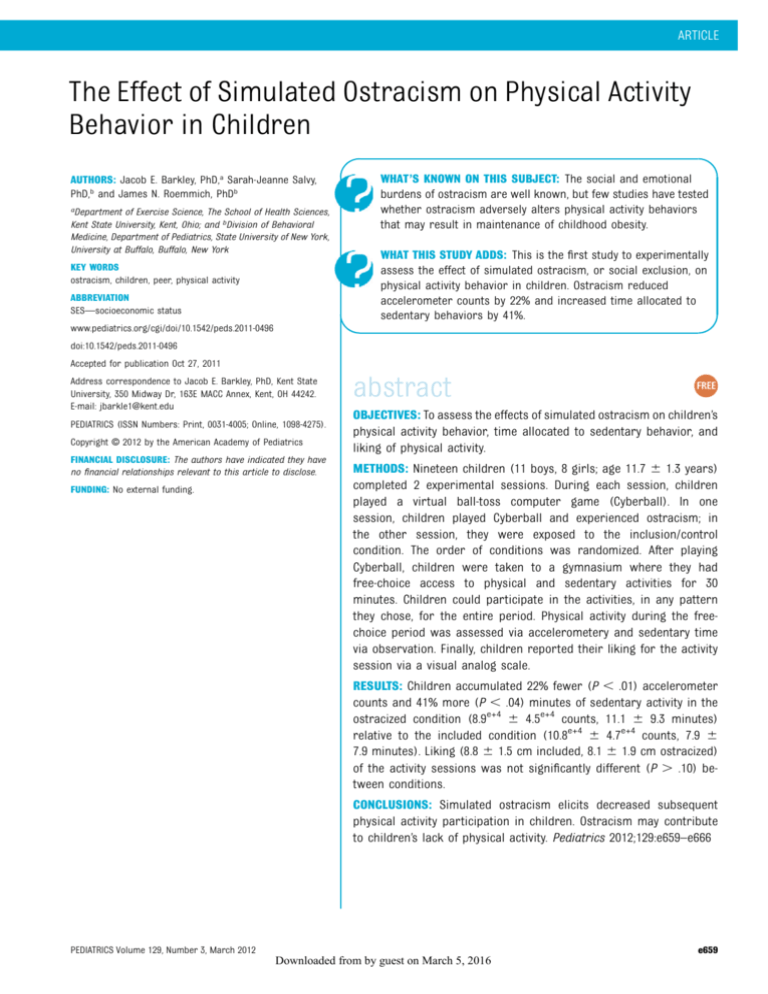
ARTICLE
The Effect of Simulated Ostracism on Physical Activity
Behavior in Children
AUTHORS: Jacob E. Barkley, PhD,a Sarah-Jeanne Salvy,
PhD,b and James N. Roemmich, PhDb
aDepartment of Exercise Science, The School of Health Sciences,
Kent State University, Kent, Ohio; and bDivision of Behavioral
Medicine, Department of Pediatrics, State University of New York,
University at Buffalo, Buffalo, New York
KEY WORDS
ostracism, children, peer, physical activity
ABBREVIATION
SES—socioeconomic status
WHAT’S KNOWN ON THIS SUBJECT: The social and emotional
burdens of ostracism are well known, but few studies have tested
whether ostracism adversely alters physical activity behaviors
that may result in maintenance of childhood obesity.
WHAT THIS STUDY ADDS: This is the first study to experimentally
assess the effect of simulated ostracism, or social exclusion, on
physical activity behavior in children. Ostracism reduced
accelerometer counts by 22% and increased time allocated to
sedentary behaviors by 41%.
www.pediatrics.org/cgi/doi/10.1542/peds.2011-0496
doi:10.1542/peds.2011-0496
Accepted for publication Oct 27, 2011
Address correspondence to Jacob E. Barkley, PhD, Kent State
University, 350 Midway Dr, 163E MACC Annex, Kent, OH 44242.
E-mail: jbarkle1@kent.edu
PEDIATRICS (ISSN Numbers: Print, 0031-4005; Online, 1098-4275).
Copyright © 2012 by the American Academy of Pediatrics
FINANCIAL DISCLOSURE: The authors have indicated they have
no financial relationships relevant to this article to disclose.
FUNDING: No external funding.
abstract
OBJECTIVES: To assess the effects of simulated ostracism on children’s
physical activity behavior, time allocated to sedentary behavior, and
liking of physical activity.
METHODS: Nineteen children (11 boys, 8 girls; age 11.7 6 1.3 years)
completed 2 experimental sessions. During each session, children
played a virtual ball-toss computer game (Cyberball). In one
session, children played Cyberball and experienced ostracism; in
the other session, they were exposed to the inclusion/control
condition. The order of conditions was randomized. After playing
Cyberball, children were taken to a gymnasium where they had
free-choice access to physical and sedentary activities for 30
minutes. Children could participate in the activities, in any pattern
they chose, for the entire period. Physical activity during the freechoice period was assessed via accelerometery and sedentary time
via observation. Finally, children reported their liking for the activity
session via a visual analog scale.
RESULTS: Children accumulated 22% fewer (P , .01) accelerometer
counts and 41% more (P , .04) minutes of sedentary activity in the
ostracized condition (8.9e+4 6 4.5e+4 counts, 11.1 6 9.3 minutes)
relative to the included condition (10.8e+4 6 4.7e+4 counts, 7.9 6
7.9 minutes). Liking (8.8 6 1.5 cm included, 8.1 6 1.9 cm ostracized)
of the activity sessions was not significantly different (P . .10) between conditions.
CONCLUSIONS: Simulated ostracism elicits decreased subsequent
physical activity participation in children. Ostracism may contribute
to children’s lack of physical activity. Pediatrics 2012;129:e659–e666
PEDIATRICS Volume 129, Number 3, March 2012
Downloaded from by guest on March 5, 2016
e659
Positive interaction with peers and
friends is associated with increased
participation in physical activity in children and adolescents.1–6 This has been
demonstrated by using survey research
and, to a lesser extent, in a few controlled studies where the presence or
absence of peers and/or friends was
manipulated.1–6 Conversely, negative
social interactions with peers (ie, peer
victimization or rejection and prejudice)
have been correlated with decreased
physical activity participation in children and adolescents.7–14 This is problematic, as a lack of physical activity in
children and adolescents is associated
with the development of obesity and
other health difficulties.15–18 The research on adverse social interaction
and physical activity would greatly
benefit from experimental designs that
allow for stronger causal inferences.
Furthermore, the existing research on
adverse social interaction and physical
activity has focused almost exclusively on
overt peer victimization and criticism7–14
and no study, to our knowledge, has examined the specific impact of ostracism
or social exclusion on youths’ physical
activity. In contrast to overt peer rejection and criticism that often involves
explicit declarations that an individual
or group is not wanted, ostracism is the
intentional ignoring or excluding of an
individual or group by another individual
or group.19 Ostracism threatens an
individual’s need to belong and also
produces psychological and physiologic
responses that are indicative of a stress
response.20,21 The social and emotional
burdens of ostracism are well known,22,
23 but no studies have tested whether
ostracism adversely alters physical activity behaviors.
This study assessed the effects of simulated ostracism on children’s physical
activity behavior and liking of that
physical activity. The Cyberball game
was used to induce ostracism or inclusion. Cyberball is a well-validated
e660
computerized ball-tossing game used
to induce a brief episode of simulated
ostracism or include the individual in
game play.24–27 When playing Cyberball
and experiencing ostracism, individuals exhibit both perceptual and physiologic changes that can be observed in
a research setting. Individuals who
play Cyberball and experience ostracism report greater feelings of sadness, aloneness, and exclusion versus
those being included during Cyberball
play.23 In addition, functional MRI of
brain activity has shown that experiencing the “social pain” of ostracism
during Cyberball game play is very
similar to experiencing physical pain.20
,21 Liking (ie, hedonics) was assessed
via a validated visual analog scale and
is an effective rating of a behavior that
is controlled by the opioid neurotransmitter system.28 Liking of physical
activity is associated with actual physical activity behavior in children.29–32 We
hypothesized that simulated ostracism
would decrease children’s amount of
physical activity and their liking of the
activity and increase the time allocated
to sedentary behavior relative to an
included condition.
METHODS
Participants
A total of 19 children (11 boys, 8 girls)
between the ages of 8 and 12 years with
no contraindications to physical activity
participated in the current study. Participants were recruited through flyers
posted in the local community and from
a database of individuals who had previously contacted the Applied Physiology
Laboratory at Kent State University to
participate in separate, unrelated
studies. Children were excluded if
they exhibited any contraindications
(eg, orthopedic injury) to physical
activity. Before participation, children
and their parent/guardian read and
signed informed assent and consent
forms, respectively. This study was
BARKLEY et al
Downloaded from by guest on March 5, 2016
approved by the Kent State University
Institutional Review Board.
Procedures
Children meeting the entry criteria
were invited to the Applied Physiology
Laboratory at Kent State University for 2
separate visits. During the first visit,
children’s height and weight were
assessed, and children then sampled
the physical and sedentary activities in
a gymnasium that was located within
the same building and on the same
floor as the Applied Physiology Laboratory (described later in this article).
The walk to the gymnasium from the
laboratory took ∼1 minute.
After sampling the activities, children
played the virtual ball-toss computer
game, Cyberball, in the laboratory.
Cyberball is a ball-throwing simulation
that appears as a simulated Internet
browser on a computer. The game has
been used in adults and youth.33,34
During Cyberball, the participant controls the character at the bottom of the
screen, and there are 2 additional
characters that are programmed by
the computer to either include or exclude the participant from the balltossing game. Participants are told
they are playing the Cyberball game
over the Internet with 2 other children
who are “like them.” Participants are
told they can throw the ball to either
player on the screen. By mouse-clicking
on the appropriate player’s icon, the
participant then passes the ball to that
player. In the ostracized condition, the
participant receives the ball twice, and
thereafter, never receives it again. In
the included condition, the participant
receives the ball 33% of the time. In
both conditions, there are a total of 30
throws and the manipulation lasts 3
minutes. Cyberball has been shown to
be a valid simulation of ostracism, as
individuals who play the game in the
ostracized condition have reliably
reported greater negative feelings
ARTICLE
(ie, feeling “bad”), having less control
of their emotions, and having less of a
sense of belonging to a group.23
During 1 session, participants were
assigned to the ostracism condition and
were accordingly socially excluded.
During the other session, participants
were exposed to the inclusion/control
condition. The order of presentation
of the conditions was randomly determined across participants. After completing the Cyberball game on both
visits, participants completed a manipulation check to assess the effects
of Cyberball on psychological needs,
moods, and perception of inclusion/
exclusion (described later in this article).
After completing the manipulation
check, participants were given free
access to the previously sampled activities for 30 minutes. Children were
free to use any of the physical and/or
sedentary activity equipment they
wished, in any pattern, for the entire
session. Children’s behavior was monitored by a member of the research
team who was present in the gymnasium discreetly observing the participant. To minimize the impact of social
influence on the children’s behavior,
there were no additional individuals in
the gymnasium during each 30-minute
activity session other than the research
team member observing the child. At the
conclusion of the 30-minute session,
participants were asked to report their
liking of that session. All activity sessions
took place between Monday and Friday,
after school time in the late afternoon (3
PM) to early evening (6 PM). At the end of
the second visit, all participants were
debriefed as to the true nature of the
experiment, and they were compensated for their participation with a
$20.00 gift card to a local store.
Children were given free access to
physical and sedentary activities
in a 4360-sq ft gymnasium during each
30-minute activity session. Physical
activities/equipment included the
following: five 1-ft (0.305 m)-tall modified hurdles, jump rope, several Nerf
footballs and flying discs with targets
and goals (Hasbro, Pawtucket, RI),
standing long jump, kicking a soccer
ball around a series of 7 cones, shooting
a basketball at a standard 10-ft (3.05 m)
hoop, and navigating an obstacle
course made up of gymnastic/soft-play
equipment (UCS Inc, Lincolnton, NC).
The obstacle course consisted of the
following: foam gymnastic/soft-play
equipment arranged in order, one 60in (1.52 m)-long by 48-in (1.22 m)-wide
ramp ascending at 15° to a peak
height of 15 in (0.38 m) butting up to
a 34-in (0.86 m)-long by 24-in (0.69 m)diameter octagonal cylinder laid horizontally. Immediately after the cylinder
there was a 60-in (1.52 m)-long by 36-in
(0.91 m)-wide ramp ascending at 15° to
a peak height of 15 in (0.38 m) butting
up to a 48-in (1.22 m)-tall octagonal
ring with a 28-in (0.71 m) diameter
opening and another 60-in (1.52 m)long by 36-in (0.91 m)-wide ramp
placed in a descending fashion, after
the octagonal ring. Sedentary activities/
equipment were located on a table, with
a chair, within the gymnasium and included drawing, crossword puzzles,
word finds, reading magazines, and
the matching game Perfection (Milton
Bradley Company, East Longmeadow, MA).
(ActiGraph, Pensacola, FL) on their hips,
snug against the body. Epoch length was
set to 60 seconds and per-minute accelerometer counts were summed for the
measure of physical activity behavior per
activity session. The ActiGraph is a valid
and reliable tool for quantifying physical
activity in children and adolescents.36
Sedentary Activity Observation
During each 30-minute activity session,
the amount of time children allocated to
participating in sedentary activities was
monitored via a stopwatch (Traceable
Stopwatch, Fisher Scientific, Waltham,
MA) and recorded on a data-entry form
by the investigator discretely observing
the session. Children were informed that
the observer was present to ensure their
safety while playing alone in the gymnasium. To minimize the observer’s influence on children’s behavior, once an
activity session began, the investigator
observing the session did not speak
with the child unless the child asked a
question related to the activity session
or the child’s behavior was placing the
child at risk (ie, misuse of equipment in
the gymnasium). Sedentary time was
recorded from the moment the child
came to the sedentary table and sat in
the chair. Children were informed that if
they wished to participate in the “table”
(ie, sedentary) activities, they were to do
so while seated.
Measurements
Anthropometrics
Liking
Body weight was assessed to the
nearest 0.2 kg by using a balance-beam
scale (Health O Meter, Alsip, IL). Height
was assessed to the nearest 1.0 mm
using a calibrated stadiometer (Health
O Meter). The Centers for Disease
Control and Prevention’s BMI Percentile
Calculator for Child and Teen was used
to calculate BMI percentile.35
Liking of the physical activities from each
30-minute activity session was assessed
using a visual analog scale consisting of
a 10-cm line anchored by “do not like it at
all” on the left side and “like it very much”
on the right side. Liking, or hedonics, is
an effective rating of a behavior that
directly correlates with physical activity participation.29–32
Accelerometry
Manipulation Check
During each 30-minute activity session,
children woreanActiGraphGT1MMonitor
Immediately on completion of Cyberball
game play, during both conditions
PEDIATRICS Volume 129, Number 3, March 2012
Downloaded from by guest on March 5, 2016
e661
(ostracized, included), children read and
completed the Aversive ImpactIndex.The
Aversive Impact Index is a validated
questionnaire designed to assess positive and negative affective states after
Cyberball play.23 Each statement (eg, “I
felt rejected”) requires participants to
respond across a 5-point scale anchored by 1 “Not at all” to 5 “Extremely.”
The scores from each positive statement (eg, “I felt good about myself”)
and each negative statement (eg, “I
felt rejected”) were separately summed to provide indices of positive and
negative affective states after each
time children played Cyberball. The
Aversive Impact Index also assesses
participants’ perceptions of how frequently they were thrown the ball
and how excluded they were during
Cyberball play. If a child required assistance when completing the Aversive
Impact Index (eg, clarification of any of
the items on the questionnaire), it was
provided by a member of the research
team.
Statistical Analysis
Individual Characteristics
Differences in boys’ and girls’ physical
characteristics (height, weight, BMI
percentile, and age) were analyzed
with independent-sample t tests.
Manipulation Check
Wilcoxon signed-rank tests were used
to assess differences across the included and ostracized conditions in the
scores from the negative and positive
items on the Aversive Impact Index, how
frequently children perceived they received the ball, and how excluded they
felt. Spearmancorrelationanalyseswere
used to assess relationships between
changes in the positive and negative
items on the Aversive Impact Index and
changes in measures of physical activity behavior and liking of each activity
session from the included to the
ostracized conditions.
e662
Effects of Ostracism
Two gender (male, female) by 2 conditions
(included, ostracized) analyses of variance with repeated measures were used
to assess differences in accelerometer
counts,timeallocatedtosedentaryactivity,
and liking across the conditions. There
were no significant main (F[1, 17] ,0.90,
P . .3) or interaction (F[1, 17] ,0.96, P .
.3) effects of gender, so results from these
analyses are described with both genders
pooled into a single group.
All statistical analyses were conducted
using SPSS for Windows (version 17.0,
SPSS Inc, Chicago, IL).
RESULTS
Individual Characteristics
Participant physical characteristics are
shown in Table 1. There were no significant differences for age, height,
weight, or BMI percentile (t[18] #1.70,
P $ .12) between boys and girls.
Manipulation Check
Children had greater scores for the
negative items (z = 3.4, P = .001) and
lower scores for the positive items (z =
3.1, P = .002) on the Aversive Impact
Index in the ostracized condition than
in the included condition (Table 2).
Children indicated greater feelings of
being excluded (z = 3.6, P , .001) and
ignored (z = 3.7, P , .001) during the
ostracized condition relative to the included condition (Table 2). Children
also indicated that they received a
greater (z = 3.8, P , .001) percentage
of the total throws in the included
condition (M = 33.1, SD = 8.6) than the
TABLE 1 Participant Physical
Characteristics
Variable
Boys
(n = 11)
Girls
(n = 8)
Age, y
Height, cm
Weight, kg
BMI percentile
11.3 6 1.7
148.5 6 12.3
53.7 6 25.7
74.0 6 27.0
11.5 6 1.9
151.2 6 10.7
42.1 6 9.4
52.4 6 29.7
Data are presented as the means 6 SD.
BARKLEY et al
Downloaded from by guest on March 5, 2016
ostracized condition (M = 9.6, SD = 7.2).
Although the manipulation elicited
changes in mood measures, mood
measures were not (P . .18) correlated
with the behavioral measures or liking
of the activity sessions. For example,
changes in accelerometer counts from
the included to ostracized conditions
were not correlated with changes in the
total positive (r = 20.33, P . .18) or
negative (r = 0.13, P . .6) scores from
items on the Aversive Impact Index.
Effects of Ostracism
Children accumulated more accelerometer counts (F[1, 17] = 10.10, P , .01)
in the included condition than in the
ostracized condition (Fig 1). Children
allocated more time to sedentary activity (F[1, 17] = 4.95, P = .04) in the
ostracized condition than the included
condition (Fig 1). There were no significant differences (F[1, 17] ,1.0, P . .10)
in liking (M = 8.8, SD = 1.5 cm included,
M = 8.1, SD = 1.9 cm ostracized) between the ostracism and the inclusion
conditions.
DISCUSSION
This is the first study to assess the acute
impact of a bout of simulated ostracism
on children’s choice to be physically
active or sedentary. Findings indicated
that children accumulated 22% fewer
accelerometer counts and allocated
41% more time to sedentary activities
in the ostracism condition than the
inclusion/control condition. The current results suggest that ostracism
may directly reduce physical activity
and increase sedentary behaviors.
These findings are worrisome, because
the lack of physical activity and engagement in sedentary behaviors in
children and adolescents are concurrently and prospectively related to
obesity and other health difficulties.15–18
Although the ways in which difficulties
with peers and friends affect youths’
cognitive and psychosocial development
ARTICLE
TABLE 2 Aversive Impact Index and Manipulation Check Scores
Variable
Included
(n = 19)
Ostracized
(n = 19)
AII: Negative items*
AII: Positive items*
MC: Feelings of being excluded*
MC: Feelings of being ignored*
17.2 6 7.0
31.2 6 6.7
1.5 6 0.9
1.3 6 0.7
30.2 6 9.8
22.4 6 7.5
3.8 6 1.4
4.0 6 1.3
Data are presented as the means 6 SD. AII, Aversive Impact Index scores; MC, manipulation check scores.
* Significant difference between the included and ostracized conditions (P , .002).
FIGURE 1
Total accelerometer counts (upper panel) and minutes of sedentary activity (bottom panel). *Significant differences between the included and ostracized conditions (P , .04).
have been well studied,22,23,37 few
studies have examined the impact of
social adversity on youths’ physical
activity and sedentary behavior.7–14
These previous studies have indicated
that children who report a greater
amount of social adversity report less
physical activity behavior than their
socially accepted peers. The existing
literature on social adversity and
physical activity behavior in children,
however, is limited to self-report data
and lacks the use of carefully controlled experimental designs. The current work extends previous research
by using an experimental design and
conducting the experiment in a controlled environment, which provided
PEDIATRICS Volume 129, Number 3, March 2012
Downloaded from by guest on March 5, 2016
the ability to manipulate ostracism and
inclusion and determine the extent to
which ostracism caused a reduction in
subsequent physical activity and sedentary behaviors in children.
Interestingly, the current findings indicate that physical activity behavior
was decreased after an episode of ostracism, whereas liking of the activity
sessions was not affected. Although it is
unclear why such a paradoxical effect
occurred, previous research may offer
some insight. Previous research has
indicated that mood or emotional distress is not the process mediating
behavioral changes in response to
ostracism.38–40 Our own findings of a
lack of a relationship between changes
in the Aversive Impact Index and physical activity behavior support this. Instead, Williams19 has suggested that
ostracism is similar to experiencing
“physical pain.” This “pain” causes the
brain to focus on the source of the
ostracism and apply the appropriate
coping mechanism (ie, “freezing”; becoming still or motionless) and this
could promote greater sedentary behavior.40 The preoccupation in finding
a coping mechanism after ostracism
negatively affects performance on
tasks that involve active thought or
those that require executive function.41
If ostracism impairs executive function,
it likely affects the decision to respond
actively.41–43 Ostracism may temporarily paralyze or induce a state of apathy
or inhibit behavioral activation in participants, promoting sedentary choices;
however, because the effects of ostracism are temporary, by the end of the
30-minute activity session (when liking
was assessed) children may have recovered and begun to like the physical
activity as much as the included condition. Future studies would benefit
from assessing activity liking at multiple times to determine if it improves as
the effects of ostracism likely abate, and
also whether engagement in physical
e663
activity helps in recovering following
social exclusion.
Although the current study is the first to
examine the effect of ostracism on
physical activity behavior, previous
studies have examined the effects of
simulated ostracism on eating. Each of
these previous studies demonstrated
that a bout of ostracism increases
eating behavior.33,34,44,45 These studies
also identified possible factors that
moderate the effects of ostracism on
eating behavior. Adults who were considered socially anxious33 and those
prone to overeating44 ate more after
experiencing ostracism than adults
who were not socially anxious or prone
to overeating. Ostracism also increases
overweight youths’ motivation to eat and
food intake, whereas nonoverweight
youth do not alter their eating behavior
or motivation after experiencing ostracism.34 It is possible that additional factors, that were not presently assessed,
also act to moderate the effects of ostracism on physical activity behavior.
Given the previous evidence supporting
the importance of children’s weight
status,46 the relative reinforcing value of
physical activity versus sedentary alternatives,47 and self-efficacy for physical
activity48,49 in predicting physical activity
behavior in children, it would be logical
to assess such variables as potential
mediators or moderators of the effects
of ostracism on physical activity and
sedentary behavior in future studies.
Although the present results are intriguing, there are limitations to this
study. Primarily, the sample size (n =
19) was small and children were not
recruited based on adiposity. Recruiting a larger sample size of both normal
weight and overweight/obese youth
would allow for the assessment of the
moderators proposed previously (ie,
overweight status, relative reinforcing
value, and self-efficacy for physical
activity), as well as additional potential
moderators that were not presently
assessed, such as self-reported physical activity and eating behaviors. Although the sample size from the
current study was small, the accelerometer counts data from the included
and ostracized conditions were normally distributed and the difference
between these conditions was easily
large enough (22%) to yield statistical
significance. Future studies should
measure liking or other possible mediators more frequently during the
activity sessions, as these variables
may fluctuate the longer a participant
is physically active after being ostracized. This was also a fairly homogeneous sample in that all, except 2
(Hispanic), of the children were white.
Future research should examine
a more ethnically diverse group of
participants. Furthermore, although all
the families in the current study largely
came from middle-class suburban
neighborhoods and small cities, there
was no specific assessment of parental
socioeconomic status (SES). Assessment of parental SES will be important
for understanding whether it moderates the effect of ostracism on activity
choice and to inform to which SES
levels these results may be generalized. We also acknowledge that volunteer bias is a potential limitation and
this may help explain the homogeneity
of the sample.
physical activity, this is the first study
to experimentally examine the effects
of a brief episode of simulated ostracism on subsequent physical and
sedentary activity behavior in children. Children exhibited a decrease
in physical activity counts and an increase in time allocated to sedentary
behavior after being ostracized relative to the included condition. This
suggests that experiencing ostracism
has an immediate negative impact
on children’s choice to be physically
active. These findings are consistent with previous results from
nonexperimental survey research,
indicating that social adversity is
associated with lower levels of physical activity participation in children. Additional research examining
potential differences in these effects between normal weight and
overweight/obese children is warranted, because overweight youth
are at greater risk of difficulties with
the larger peer group. The present
results provide the first causal evidence that ostracism may reinforce
behaviors that lead to obesity in
children. The consideration of the
effect of adverse social interaction
on physical activity behavior may further our understanding of physical and
behavioral health trajectories.
Although previous, nonexperimental
studies have shown a link between selfreported social adversity and a lack of
ACKNOWLEDGMENTS
Dr Jason D. Ridgel, Fellow of the
American Academy of Family Practice,
contributed to the review of this manuscript. As a family physician, Dr Ridgel
ensured that the terminology used
herein was appropriate for family physicians and pediatricians. The authors
sincerely thank Dr Ridgel for his expert assistance.
physical activity performed in 8- to 12-yearold boys. Pediatr Exerc Sci. 2011;23(1):49–60
2. Salvy SJ, Bowker JW, Roemmich JN, et al.
Peer influence on children’s physical
CONCLUSIONS
REFERENCES
1. Rittenhouse MA, Salvy SJ, Barkley JE. The
effect of peer influence on the amount of
e664
BARKLEY et al
Downloaded from by guest on March 5, 2016
ARTICLE
3.
4.
5.
6.
7.
8.
9.
10.
11.
12.
13.
14.
activity: an experience sampling study.
J Pediatr Psychol. 2008;33(1):39–49
Salvy SJ, Roemmich JN, Bowker JC,
Romero ND, Stadler PJ, Epstein LH. Effect
of peers and friends on youth physical
activity and motivation to be physically
active. J Pediatr Psychol. 2009;34(2):217–
225
Duncan SC, Duncan TE, Strycker LA. Sources and types of social support in youth
physical activity. Health Psychol. 2005;24(1):
3–10
Finnerty T, Reeves S, Dabinett J, Jeanes YM,
Vögele C. Effects of peer influence on dietary
intake and physical activity in schoolchildren. Public Health Nutr. 2010;13(3):
376–383
Springer AE, Kelder SH, Hoelscher DM.
Social support, physical activity and sedentary behavior among 6th-grade girls:
a cross-sectional study. Int J Behav Nutr Phys
Act. 2006;3(1):8
Faith MS, Leone MA, Ayers TS, Heo M, Pietrobelli A. Weight criticism during physical
activity, coping skills, and reported physical activity in children. Pediatrics. 2002;110
(2 pt 1). Available at: www.pediatrics.org/
cgi/content/full/110/2pt1/e23
Gosling R, Stanistreet D, Swami V. ‘If Michael Owen drinks it, why can’t I?’ — 9 and
10 year olds’ perceptions of physical activity and healthy eating. Health Educ J.
2008;67(3):167–181
Hohepa M, Scragg R, Schofield G, Kolt GS,
Schaaf D. Social support for youth physical
activity: importance of siblings, parents,
friends and school support across a segmented school day. Int J Behav Nutr Phys
Act. 2007;4:54
Kunesh MA, Hasbrook CA, Lewthwaite R.
Physical activity socialization: peer interactions and affective responses among a
sample of sixth grade girls. Sociol Sport J.
1992;9:385–396
Page RM, Frey J, Talbert R, Falk C. Children’s
feelings of loneliness and social dissatisfaction: Relationship to measures of physical fitness and activity. J Teach Phys Educ.
1992;11:211–219
Smith AL. Perceptions of peer relationships
and physical activity participation in early
adolescence. J Sport Exerc Psychol. 1999;
21:329–350
Storch EA, Milsom VA, Debraganza N, Lewin
AB, Geffken GR, Silverstein JH. Peer victimization, psychosocial adjustment, and physical activity in overweight and at-risk-foroverweight youth. J Pediatr Psychol. 2007;
32(1):80–89
Slater A, Tiggemann M. Gender differences
in adolescent sport participation, teasing,
15.
16.
17.
18.
19.
20.
21.
22.
23.
24.
25.
26.
27.
28.
29.
self-objectification and body image concerns. J Adolesc. 2011;34(3):455–463 [Corrected Proof.]
Anderssen SA, Holme I, Urdal P, Hjermann I.
Associations between central obesity and
indexes of hemostatic, carbohydrate and
lipid metabolism. Results of a 1-year intervention from the Oslo Diet and Exercise
Study. Scand J Med Sci Sports. 1998;8(2):
109–115
Dietz WH, Jr, Gortmaker SL. Do we fatten
our children at the television set? Obesity
and television viewing in children and
adolescents. Pediatrics. 1985;75(5):807–812
Dietz WH, Gortmaker SL. Preventing obesity
in children and adolescents. Annu Rev
Public Health. 2001;22:337–353
Dietz WH, Robinson TN. Clinical practice.
Overweight children and adolescents.
N Engl J Med. 2005;352(20):2100–2109
Williams KD. Ostracism: the kiss of social
death. Social and Personality Psychology
Compass. 2007;1(1):236–247
Eisenberger NI, Lieberman MD. Why rejection hurts: a common neural alarm
system for physical and social pain. Trends
Cogn Sci. 2004;8(7):294–300
Eisenberger NI, Lieberman MD, Williams KD.
Does rejection hurt? An FMRI study of social exclusion. Science. 2003;302(5643):
290–292
Smart Richman L, Leary MR. Reactions to
discrimination, stigmatization, ostracism,
and other forms of interpersonal rejection:
a multimotive model. Psychol Rev. 2009;116
(2):365–383
Williams KD, Cheung CK, Choi W. Cyberostracism: effects of being ignored over the
Internet. J Pers Soc Psychol. 2000;79(5):
748–762
van Beest I, Williams KD. When inclusion
costs and ostracism pays, ostracism still
hurts. J Pers Soc Psychol. 2006;91(5):918–
928
Sebastian C, Blakemore SJ, Charman T.
Reactions to ostracism in adolescents with
autism spectrum conditions. J Autism Dev
Disord. 2009;39(8):1122–1130
Williams KD, Jarvis B. Cyberball: a program
for use in research on interpersonal ostracism and acceptance. Behav Res Methods. 2006;38(1):174–180
Harmon-Jones E, Peterson CK, Harris CR.
Jealousy: novel methods and neural correlates. Emotion. 2009;9(1):113–117
Berridge KC. Food reward: brain substrates
of wanting and liking. Neurosci Biobehav
Rev. 1996;20(1):1–25
Craig S, Goldberg J, Dietz WH. Psychosocial
correlates of physical activity among fifth
PEDIATRICS Volume 129, Number 3, March 2012
Downloaded from by guest on March 5, 2016
30.
31.
32.
33.
34.
35.
36.
37.
38.
39.
40.
41.
42.
and eighth graders. Prev Med. 1996;25(5):
506–513
Motl RW, Dishman RK, Saunders R, Dowda
M, Felton G, Pate RR. Measuring enjoyment
of physical activity in adolescent girls. Am J
Prev Med. 2001;21(2):110–117
DiLorenzo TM, Stucky-Ropp RC, Vander Wal
JS, Gotham HJ. Determinants of exercise
among children. II. A longitudinal analysis.
Prev Med. 1998;27(3):470–477
Roemmich JN, Barkley JE, Lobarinas CL,
Foster JH, White TM, Epstein LH. Association
of liking and reinforcing value with children’s physical activity. Physiol Behav. 2008;
93(4-5):1011–1018
Oaten M, Williams KD, Jones A, Zadro L. The
effects of ostracism on self-regulation in
the socially anxious. J Soc Clin Psychol.
2008;27(5):471–504
Salvy SJ, Bowker JC, Nitecki LA, Kluczynski
MA, Germeroth LJ, Roemmich JN. Impact
of simulated ostracism on overweight and
normal-weight youths’ motivation to eat
and food intake. Appetite. 2011;56(1):39–
45
Centers for Disease Control and Prevention. BMI percentile calculator for child
and teen. Available at: http://apps.nccd.
cdc.gov/dnpabmi/. Accessed September 1,
2010
Freedson P, Pober D, Janz KF. Calibration of
accelerometer output for children. Med
Sci Sports Exerc. 2005;37(suppl 11):S523–
S530
Forgas JP, Williams KD, Wheeler L. The Social Mind: Cognitive and Motivational
Aspects of Interpersonal Behavior. Cambridge, UK: Cambridge University Press;
2001
Twenge JM, Baumeister RF, Tice DM, Stucke
TS. If you can’t join them, beat them: effects
of social exclusion on aggressive behavior.
J Pers Soc Psychol. 2001;81(6):1058–1069
Twenge JM, Catanese KR, Baumeister RF.
Social exclusion causes self-defeating behavior. J Pers Soc Psychol. 2002;83(3):606–
615
Twenge JM, Catanese KR, Baumeister RF.
Social exclusion and the deconstructed
state: time perception, meaninglessness,
lethargy, lack of emotion, and self-awareness. J Pers Soc Psychol. 2003;85(3):409–423
Baumeister RF, Twenge JM, Nuss CK. Effects
of social exclusion on cognitive processes:
anticipated aloneness reduces intelligent
thought. J Pers Soc Psychol. 2002;83(4):
817–827
Baumeister RF, Bratslavsky E, Muraven M,
Tice DM. Ego depletion: is the active self a
limited resource? J Pers Soc Psychol. 1998;
74(5):1252–1265
e665
43. Muraven M, Tice DM, Baumeister RF. Selfcontrol as limited resource: regulatory
depletion patterns. J Pers Soc Psychol.
1998;74(3):774–789
44. Oliver KG, Huon GF, Zadro L, Williams KD.
The role of interpersonal stress in overeating among high and low disinhibitors.
Eat Behav. 2001;2(1):19–26
45. Baumeister RF, DeWall CN, Ciarocco NJ,
Twenge JM. Social exclusion impairs
e666
self-regulation. J Pers Soc Psychol. 2005;
88(4):589–604
46. Steinbeck KS. The importance of physical
activity in the prevention of overweight and
obesity in childhood: a review and an
opinion. Obes Rev. 2001;2(2):117–130
47. Epstein LH, Smith JA, Vara LS, Rodefer JS.
Behavioral economic analysis of activity
choice in obese children. Health Psychol.
1991;10(5):311–316
BARKLEY et al
Downloaded from by guest on March 5, 2016
48. Ball GD, Marshall JD, McCargar LJ.
Physical activity, aerobic fitness, selfperception, and dietary intake in at risk
of overweight and normal weight children. Can J Diet Pract Res. 2005;66(3):
162–169
49. Strauss RS, Rodzilsky D, Burack G, Colin M.
Psychosocial correlates of physical activity
in healthy children. Arch Pediatr Adolesc
Med. 2001;155(8):897–902
The Effect of Simulated Ostracism on Physical Activity Behavior in Children
Jacob E. Barkley, Sarah-Jeanne Salvy and James N. Roemmich
Pediatrics 2012;129;e659; originally published online February 6, 2012;
DOI: 10.1542/peds.2011-0496
Updated Information &
Services
including high resolution figures, can be found at:
/content/129/3/e659.full.html
References
This article cites 47 articles, 6 of which can be accessed free
at:
/content/129/3/e659.full.html#ref-list-1
Subspecialty Collections
This article, along with others on similar topics, appears in
the following collection(s):
Sports Medicine/Physical Fitness
/cgi/collection/sports_medicine:physical_fitness_sub
Permissions & Licensing
Information about reproducing this article in parts (figures,
tables) or in its entirety can be found online at:
/site/misc/Permissions.xhtml
Reprints
Information about ordering reprints can be found online:
/site/misc/reprints.xhtml
PEDIATRICS is the official journal of the American Academy of Pediatrics. A monthly
publication, it has been published continuously since 1948. PEDIATRICS is owned, published,
and trademarked by the American Academy of Pediatrics, 141 Northwest Point Boulevard, Elk
Grove Village, Illinois, 60007. Copyright © 2012 by the American Academy of Pediatrics. All
rights reserved. Print ISSN: 0031-4005. Online ISSN: 1098-4275.
Downloaded from by guest on March 5, 2016
The Effect of Simulated Ostracism on Physical Activity Behavior in Children
Jacob E. Barkley, Sarah-Jeanne Salvy and James N. Roemmich
Pediatrics 2012;129;e659; originally published online February 6, 2012;
DOI: 10.1542/peds.2011-0496
The online version of this article, along with updated information and services, is
located on the World Wide Web at:
/content/129/3/e659.full.html
PEDIATRICS is the official journal of the American Academy of Pediatrics. A monthly
publication, it has been published continuously since 1948. PEDIATRICS is owned,
published, and trademarked by the American Academy of Pediatrics, 141 Northwest Point
Boulevard, Elk Grove Village, Illinois, 60007. Copyright © 2012 by the American Academy
of Pediatrics. All rights reserved. Print ISSN: 0031-4005. Online ISSN: 1098-4275.
Downloaded from by guest on March 5, 2016

